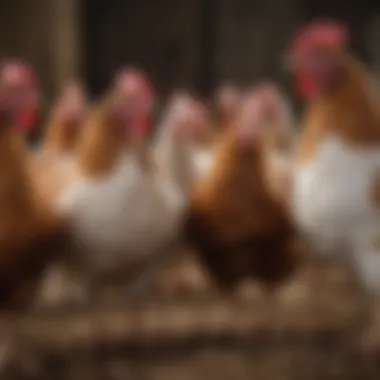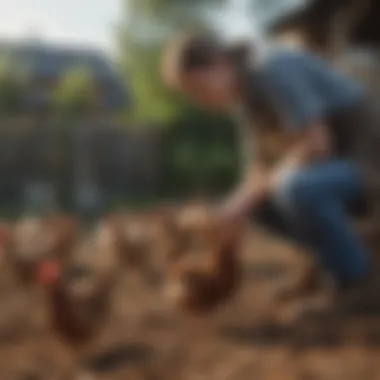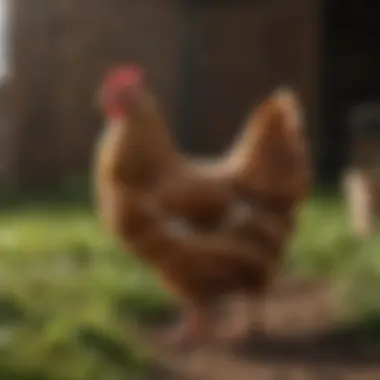Understanding the Costs Associated with Raising Hens


Intro
Raising hens has grown in popularity among individuals and families. The allure lies not just in the fresh eggs, but also in the experience of caring for animals. However, before embarking on this journey, it is critical to understand the financial implications involved in hen ownership. This article examines the economic aspects that potential owners should consider.
Understanding the various costs can help make informed decisions. The expenses can be broadly categorized into initial investments and ongoing costs. Through thorough analysis, one can gain insight into market variations and regional differences. This knowledge aids in preparing for the financial commitments associated with raising hens.
Initial Investment
The first expense in hen ownership is the purchase price of the hens. This cost often varies based on breed and age. For instance, pullets (young hens) can be cheaper than mature hens, which may already be laying eggs.
Common breeds and their costs include:
- Leghorn: Approximately $3-5 per bird.
- Rhode Island Red: Usually around $4-6 each.
- Silkie: A bit pricier at $10-15 per hen.
Other initial costs also include the following:
- Housing: Building or purchasing a coop can range from $200 to $2,000.
- Supplies: Feeders, waterers, and bedding materials cost about $50 to $100.
Ongoing Expenses
Once the initial investment is made, ongoing expenses arise. The most significant recurring costs include feed and healthcare.
- Feed: High-quality poultry feed can cost $15 to $30 per 50-pound bag. The average hen consumes about 1/4 to 1/3 of a pound of feed per day.
- Healthcare: Regular health check-ups and vaccinations can amount to $50 annually.
Equipment maintenance and utilities like water and electricity also contribute to ongoing financial responsibility.
Regional Differences
Prices for hens and related expenses can differ greatly depending on geographical location. Certain areas may have a robust market for poultry and therefore a lower purchase price. In contrast, remote regions could experience higher costs due to transportation.
Understanding Hen Ownership
Hen ownership is a topic gaining attention among a variety of audiences, including pet owners, small-scale farmers, and animal enthusiasts. Understanding the ins and outs of hen ownership involves more than just knowing the initial purchase price. This analysis encompasses essential factors like long-term commitments, housing needs, regulations, and the broader economic implications of chicken raising.
The Importance of Hens in Domestic Settings
Hens hold significant value in domestic environments. They contribute to food independence by providing fresh eggs. Beyond their nutritional benefits, hens can also serve as a natural methodical approach to waste management, as they eat kitchen scraps. Their foraging habits can help control pests in gardens, blending agricultural practice with eco-friendly strategies. Moreover, the presence of hens often fosters a sense of connection to nature, particularly for urban dwellers who might feel detached from traditional farming.
Additionally, hens may offer comfort and companionship. Many owners report unique bonds with their birds, which can enhance well-being while also educating families about responsibility and nurturing.
Benefits of Keeping Hens
There are multiple advantages associated with keeping hens that go beyond the allure of fresh eggs. Here are some key benefits:
- Economic Savings: By raising hens, owners can reduce grocery bills related to egg purchases. Home-raised eggs tend to have a superior taste and quality compared to store-bought options.
- Sustainable Living: Hens can promote sustainability in households. They contribute organic waste recycling by consuming vegetable scraps and garden leftovers, reducing landfill contributions.
- Education and Responsibility: For families with children, keeping hens serves as an educational opportunity. Children learn about animal care, biology, and sustainability, which cultivates a sense of responsibility.
- Biodiversity: Hen ownership can support biodiversity. By choosing to raise heritage or local breeds, owners can contribute to the preservation of these important genetic lines.
In summary, hen ownership is about more than just chickens; it’s a lifestyle choice that can contribute positively to personal health, environmental sustainability, and community connection. Understanding these elements is crucial for potential hen owners who seek a fulfilling experience in poultry farming.
Factors Influencing the Cost of Hens
Understanding the costs associated with keeping hens is crucial for those considering this endeavor. Many factors influence the initial and ongoing financial commitments. This section will provide insights into significant elements such as breed variability, age and health considerations, and the source of purchase. By recognizing these factors, potential hen owners can make more informed decisions in line with their goals and budget.
Breed Variability
The breed of hen plays a significant role in determining price. Various breeds exist, each with distinct characteristics and costs. For example, the Rhode Island Red and Leghorn are iconic choices for egg production; they generally have lower costs due to their availability. Alternatively, exotic breeds such as the Ayam Cemani may command higher prices because of their rarity and unique appearance.
When selecting hens based on breed, consider these factors:


- Egg production levels: Some breeds are prolific layers, generating more income if your intent is commercial.
- Hardiness: Certain breeds thrive in specific climates and environments, impacting their upkeep costs.
- Temperament: Social behavior varies by breed, influencing their suitability for family settings or mixed flocks.
Ultimately, weighing the long-term benefits against the initial costs tied to specific breeds can guide buyers towards informed choices.
Age and Health Considerations
The age of a hen affects its purchasing cost as well as long-term value. Younger hens, or pullets, usually cost more upfront but typically have more productive years ahead. Conversely, older hens, while cheaper to buy, may yield fewer eggs and require earlier replacement.
Additionally, health plays a vital role in the overall cost. Hens that have been well-cared for and are disease-free may cost more initially, but their reduced risk of requiring veterinary care means overall lower costs in the long run. When considering age and health:
- Vaccination status: Hens that have been vaccinated often carry a higher price tag, reflecting in their potential health savings.
- Breeder reputation: Purchasing from reputable breeders can ensure higher health standards, even if initial prices are steeper.
Thus, potential owners must consider the balance between immediate costs and longevity in their investment.
Source of Purchase
Where to purchase hens is another crucial factor influencing their cost. Different sources, such as local farms, hatcheries, or online marketplaces, present varying price points and levels of reliability.
- Local farms: These often provide a hands-on approach where buyers can see the conditions in which hens are raised. Prices may vary but often reflect quality.
- Hatcheries: Reputable hatcheries offer a broader selection and can provide some guarantees for health, but prices may be higher due to shipping and handling.
- Online marketplaces: While convenient, purchasing through these channels might come with risks related to health and shipping quality.
The source of purchase does not only affect initial pricing but also the overall welfare of the hens, impacting future costs associated with caring for them.
By considering breed variability, age, health, and the purchase source, prospective hen owners can navigate the complex landscape of hen costs more effectively.
Average Costs of Different Hen Breeds
Understanding the costs associated with different hen breeds is crucial for prospective poultry owners. This knowledge helps in making informed decisions that align with one’s budget and specific needs. Each breed has its own price point, influenced by factors such as rarity, popularity, and utility in egg production or other agricultural purposes. Therefore, knowing the average costs can help potential owners choose a breed that fits their financial plan whilst meeting their expectations for egg quantity and quality.
Commonly Raised Breeds
Commonly raised hen breeds typically include the Rhode Island Red, Leghorn, and Plymouth Rock. These breeds are favored for their productivity and adaptability. The average price for a Rhode Island Red chick may range from $3 to $5. Leghorns, known for their high egg production, can usually be found for $2 to $4 per chick. Plymouth Rocks, similar in price to Rhode Island Reds, often fall within the same range as well.
- Rhode Island Red: $3 - $5 per chick
- Leghorn: $2 - $4 per chick
- Plymouth Rock: $3 - $5 per chick
These prices can vary slightly based on the location and the source of purchase. For instance, local feed stores might charge more compared to hatcheries or online breeders. Additionally, the overall cost can increase if one is looking for established hens rather than chicks.
Rare and Exotic Breeds
Rare and exotic breeds cater to those who seek uniqueness in their flock. Breeds such as the Ayam Cemani or the Silkies are popular among enthusiasts and can often be priced significantly higher than common breeds. For example, the Ayam Cemani, known for its all-black appearance and mystique, can cost upwards of $200 per chick. Silkies, renowned for their fluffy feathers and gentle temperament, may range from $10 to $30 each.
- Ayam Cemani: $200 or more per chick
- Silkies: $10 - $30 per chick
Acquiring rare breeds often involves a premium, reflecting their scarcity and desirability. The exotic character of these hens can also enhance their appeal in both backyard settings and small-scale farming situations.
Initial Investment: Beyond the Purchase Price
When considering hen ownership, it is essential to understand that the initial purchase price of hens is just one element of the financial commitment. The overall investment includes various costs that one must incur to provide a suitable environment and care for the birds. This section will explore two crucial aspects: housing setup costs and ongoing feeding and health requirements. By examining these elements in detail, potential owners can make informed choices about their investments in hens.
Housing and Setup Costs
Creating a safe and appropriate habitat for hens is crucial. The housing should protect them from predators, provide adequate space, and ensure they are safe from harsh weather conditions. Several elements need consideration:
- Coop Construction: Building a coop can involve various materials. Wood, metal, or even recycled materials can be used. Costs will depend on size, quality, and insulation needs.
- Run Space: Hens require an area to roam. Depending on local regulations and your space, this might mean building a larger enclosure. Costs here depend on fencing, ground cover, and maintenance.
- Nesting Boxes: Hens need a quiet space to lay eggs. Creating nesting boxes can incur additional costs for wood or other materials, especially if you are aiming for multiple boxes.
- Heat and Lighting: For those living in cooler regions, heating elements are important, especially during winter. Lighting is also necessary to maintain egg production. The price depends on the equipment’s energy efficiency and capacity.
These initial construction and setup costs can range from a few hundred to several thousand dollars depending on scale and complexity. However, investing in a solid setup can yield long-term benefits by reducing maintenance needs and ensuring hen welfare.
Feeding and Health Requirements
Proper nutrition and health care are vital for the well-being and productivity of hens. The ongoing feeding requirements significantly influence the overall cost of hen ownership. Important points to consider include:


- Type of Feed: Hens require a balanced diet including grains, proteins, and supplements. The feed's cost can vary based on whether you choose organic or standard options. An average hen consumes around half a pound of feed daily.
- Water Supply: Fresh water is essential for hydration and egg production. Consider the costs of water containers and any plumbing or irrigation systems.
- Health Supplies: Regular health checks and vaccinations can prevent disease. Budgeting for medications and supplements is necessary. The costs here also fluctuate depending on whether you use conventional or natural remedies.
Owning hens entails both initial setup and ongoing costs that can add up over time. Understanding these expenses allows potential owners to make educated decisions about their entry into poultry keeping.
In summary, while the purchase of hens may seem like a one-time expense, ongoing investments in housing, feeding, and healthcare are crucial for a successful hen ownership experience.
Ongoing Costs of Hen Ownership
Understanding the ongoing costs of hen ownership is essential for anyone considering raising poultry. This aspect encompasses various expenditures that are necessary to maintain the health and productivity of the hens. As prospective owners weigh their options, it becomes clear that the costs extend beyond the initial purchase price of the hens.
Feed and Supplies
Feeding hens is one of the most significant ongoing expenses. A balanced diet is crucial for their health and egg production. Hens require a specific blend of nutrients, which typically includes grains, protein supplements, and minerals. The type of feed varies by age, breed, and purpose. For example, laying hens need layer pellets that are fortified with calcium to support eggshell formation. Typically, owners should budget between $15 to $30 per month for feed, depending on the flock size.
In addition to feed, other supplies are necessary. This may include bedding material, such as straw or wood shavings, which is essential for maintaining a clean and healthy coop. Also, waterers and feeders need regular cleaning and possible replacement. These expenses, added together, can represent a continuous financial commitment that requires careful planning.
Veterinary Care
Veterinary care is often overlooked when estimating the ongoing costs of hen ownership. Regular veterinary check-ups can prevent diseases that may spread through your flock. Vaccination against common diseases, such as Marek's disease, is vital. Treatment costs for sick chickens can range from $50 to several hundred dollars, depending on the severity of the illness.
Routine care, including monitoring for pests like mites and providing vaccinations, can lead to healthier hens. The cost of veterinary services may vary by region, and it is wise to establish a relationship with a local vet familiar with poultry.
General Maintenance
General maintenance involves various tasks that aid in the overall upkeep of the hen environment. Regular cleaning of the coop is a non-negotiable task. A clean environment reduces the risk of disease. Additionally, outdoor space should have adequate fencing to protect hens from predators. This might require an initial setup cost but will necessitate occasional repairs or adjustments as time goes on.
Furthermore, hens naturally produce waste, which requires regular disposal. Composting can be a good option, but if not managed properly, it can lead to odors and attract pests. Thus, the ongoing effort to keep the area tidy is crucial.
In summary, the ongoing costs of hen ownership can significantly impact your financial planning. By understanding the financial commitments related to feed, veterinary care, and general maintenance, prospective hen owners can make informed decisions that ensure both the well-being of their flock and their own budget.
Regional Variations in Hen Costs
Understanding the regional variations in hen costs is crucial for prospective hen owners. The price of hens can significantly differ based on various elements such as geographical location, local demand, and access to resources. These differences can have a direct impact on the accessibility and overall financial planning for new poultry owners. By acknowledging these variations, individuals can make more informed decisions regarding their choices and budget when venturing into hen ownership.
Urban vs.
Rural Pricing
In urban areas, the cost of hens often tends to be higher compared to rural settings. This can be attributed to several factors:
- Space Limitations: Urban environments frequently have stricter zoning laws and limited space, which can influence the types of breeds available. Because of this, costs may rise due to niche market demands.
- Transportation Costs: If hens are sourced from rural areas, urban buyers may incur additional transportation expenses. This can inflate the overall price.
- Access to Suppliers: Urban areas might have fewer local suppliers of hens. This can create a reliance on larger agricultural suppliers who typically charge a premium.
Rural regions, on the other hand, often have more affordable options due to:
- Abundant Resources: There tends to be a more direct connection to farms and breeders, leading to a lower procurement cost for hens.
- Fewer Regulations: In rural areas, zoning laws are often more lenient, allowing for a greater variety of breeds at more accessible prices.
Seasonal Price Fluctuations
Price variations for hens are not only dictated by the region but also by the seasons. Throughout the year, hen prices can change due to several factors:
- Demand Surges: Spring is often a peak season for hen purchases as many people begin backyard farming, which can elevate prices. The enthusiasm for new layers or broilers often results in higher local and national demand.
- Feed Costs: Seasonal trends in feed prices may affect the retail cost of hens. In times of high feed prices, sellers might increase the cost of hens to maintain profit margins.
- Breeding Cycles: The availability of certain breeds can fluctuate throughout the year based on breeding schedules. This can directly influence prices.
Understanding the nuances of hen pricing based on location and seasons can help individuals navigate the complexities of purchasing hens wisely.
Being aware of these considerations is essential for effectively planning one’s budget and ensuring the long-term sustainability of hen ownership.
Market Trends Impacting Hen Prices
Market trends play a critical role in determining the pricing of hens. Various factors interact to create a dynamic marketplace for poultry. Understanding these influences can help potential hen owners make informed decisions. It is essential to evaluate the elements affecting market trends and the implications for long-term investment in hen ownership.


Economic Influences
Economic conditions significantly impact hen prices. Economic growth generally leads to increased demand for poultry. As consumer incomes rise, more people show interest in raising hens for personal use or small-scale farming. Higher demand often translates to increased prices. Conversely, during economic downturns, spending on non-essential items can decrease, reducing both the number of prospective hen owners and the overall demand. This might lead to lower prices in the market.
Another factor worth noting is the cost of grain and other feed ingredients. Feed expenses contribute to overall poultry costs. Therefore, fluctuations in grain prices can directly affect the expenses related to raising hens and influence market rates. When feed becomes more expensive, the cost of hens may increase as sellers adjust their prices to maintain profit margins.
Considerations
- Monitor local and global economic trends.
- Assess the cost of feed ingredients and its effect on hen prices.
- Understand demand cycles in different seasons.
Demand for Organic and Heritage Breeds
In recent years, there has been a notable shift toward organic and heritage hen breeds. This trend has emerged in response to consumer preferences for more sustainable and ethically-raised food sources. Organic hens, which are often bred and raised without synthetic pesticides or antibiotics, command higher prices. This could be due to the increased care and resources needed for organic farming practices.
Heritage breeds, on the other hand, are valued for their genetic diversity and historical significance. They often provide unique flavors and characteristics, which appeal to specialty markets. The growing demand for these breeds has driven their prices higher, creating an essential segment in the poultry market.
Important Factors
- Increased public awareness of food sources.
- Rising interest in organic farming and sustainable practices.
- Preferences for unique flavors and diverse breeds.
Considerations Before Investing in Hens
Investing in hens is not merely about the initial purchase price. It encompasses a range of factors and responsibilities that potential owners must contemplate. Understanding these considerations is crucial for successful hen ownership. These include long-term commitment and compliance with space and zoning regulations.
Long-Term Commitment
Owning hens requires a significant long-term commitment. Unlike other pets, hens are not just for show; they have a routine that must be maintained. Hens lay eggs regularly, and this can bring both joy and responsibility.
Having hens means that owners must provide consistent care daily. Factors to consider include:
- Feeding: Proper nutrition is essential for healthy hens.
- Health Care: Regular check-ups and vaccinations are necessary to prevent illness.
- Time Investment: Daily egg collection, cleaning of the coop, and general observation of the hens must fit into the owner's routine.
This responsibility can span several years as hens typically live 5 to 10 years, depending on the breed and care they receive. Therefore, potential owners should assess their ability to commit to these regular tasks.
Space and Zoning Regulations
Before bringing hens into a domestic setting, it is imperative to research local zoning laws and regulations. Many areas have specific laws governing hen ownership, including how many hens are allowed, required coop sizes, and distance from property lines.
Key points to consider include:
- Zoning Laws: Some municipalities may not allow hens at all.
- Space Requirements: Hens require adequate space for roaming, at least 4 square feet per bird in the coop, and up to 10 square feet in the run.
- Nuisance Issues: Noise and odor can lead to disputes with neighbors. Understanding local expectations can mitigate potential conflicts.
Overall, a thorough understanding of regulations is vital for compliance and ensuring a harmonious environment for both the hens and the owner.
Interested in exploring more about backyard poultry? Visit Wikipedia for detailed information.
Ending
In this article, we have engaged in a detailed exploration of the various costs associated with hen ownership. Understanding these financial implications is vital for any potential poultry owner. The conclusion serves as a reflective summary, pulling together key points discussed throughout the article while also providing clarity on the commitments involved.
Summary of Financial Considerations
The financial considerations for hen ownership extend far beyond the initial purchase price of the birds. Each potential owner must carefully evaluate:
- Initial Costs: This includes the price of purchasing the hens, housing materials, and necessary equipment. The selection of breed, whether common or exotic, directly impacts these initial expenses.
- Ongoing Expenses: Regular expenditures encompass feed, healthcare, and maintenance. These elements must be budgeted for to avoid unexpected financial strains.
- Potential Returns: While hens offer egg production, the value must be weighed against costs. The demand for organic or backyard eggs can influence potential earnings, making careful planning essential.
Understanding these costs and their implications enables aware decision-making, setting the stage for a fulfilling hobby or small-scale farming venture.
Final Thoughts on Hen Ownership
Before embarking on hen ownership, potential owners should consider the broader impact of their decision. This means analyzing local zoning regulations, understanding community standards concerning poultry, and anticipating the time required for care and management. Hen ownership is not merely a financial transaction; it embodies responsibility and commitment to animal welfare. While the yield of fresh eggs may seem enticing, the realities of daily care and investment should not be underestimated.
Engaging with like-minded communities, such as those found on platforms like Reddit or Facebook, can provide additional insights and support. Cultivating relationships with other hen owners can enrich the experience, provide empathy during challenges, and celebrate the joys of poultry ownership.
In summary, potential hen owners must approach their decision making with a blend of ambition and caution. The journey of hen ownership can be rewarding, but it demands thoughtful consideration of both financial and personal implications.







